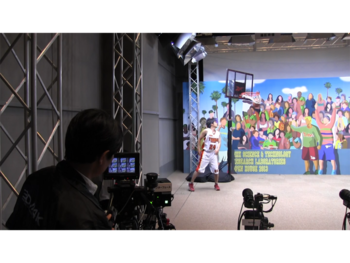Japan's public television broadcaster, NHK, has developed an array of video cameras that are synchronized to create "bullet time" shots like those popularized in the film The Matrix.

A cameraman shoots video using an experimental camera system from Japanese broadcaster NHK, which links multiple cameras to provide multiple angles of the same scene.
Video shot using the system can be used to create an effect where the subject freezes and the camera angle pans around it, commonly called "bullet time" after a famous Matrix scene. NHK has used the system with a dozen cameras synched together.
The system links its multiple cameras, each on motorized mounts, so that they can be operated by a single cameraman. One of the cameras is chosen as the master, which the others use for positioning and auto focus. Once the video is shot it is sent directly to a computer system, which can generate a clip in about a minute.
NHK is planning to initially use the system at sporting events, allowing key moments in the action to be frozen and viewed from multiple angles. The broadcaster demonstrated the system using basketball players dunking on an indoor hoop at its research facility outside of Tokyo earlier this month.
The system can also potentially be used for filming in 3D, using the slightly skewed perspective provided by the cameras' offset location.
NHK is also working on a new type of camera to make it easier to film scenes that shoot subjects against virtual backgrounds. Such systems need to constantly track the location of the camera in three-dimensional space, and some solutions involve bulky hardware that can only be used indoors.
NHK has developed a portable camera mounted with a downward-pointing laser rangefinder on a motorized mount that allows the camera to be carried by hand and swung around for shots from various angles within the virtual space.





